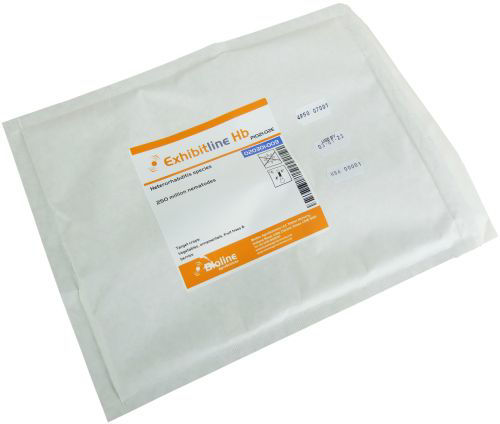Exhibitline Hb (Heterorhabditis bacteriophora) Tray of 250million
To order this product please call our Customer Services Team on 01903 726100 or email orders@fargro.co.uk
Specifications
Weight
0.56 kg
Activity / Control
Vine weevil and chafer grub The nematode worms seek vine weevil larvae in moist soil and compost, larger weevil grubs are more easily located. Nematodes enter the weevil larvae and release a small pellet of bacteria that kills the host after a few days. The parasitic worms begin to reproduce, releasing several thousand more juvenile infective nematodes able to find and kill further weevil grubs. Under the right conditions Exhibitline H may be faster to act than Nemasys L. Vine weevil larvae turn a bright red colour when infected with Heterorhabditis megidis. Chafer grub: The garden chafer Phyllopertha horticola present in turf. Other species of chafer such as the cockchafer Melolontha melolontha may not be adequately controlled owing to differences in life cycle.
Application Method
Autumn and spring are the main seasons for nematode application, although additional treatments may be needed for heated or protected crops. It is important that the soil, compost or turf is kept moist (not water logged). Apply as a drench using conventional sprayer, dilutor, watering can or through most irrigation lines. In all cases remove any fine filters and ensure water temperature is between 5 and 15°C. Ensure soil or growing media temperatures are between 12 and 30°C. Chafer grub: In accordance with the Garden Chafer life cycle - when the larvae are close to the soil surface and when the soil surface is above 12°C. Typically treat from August to September. Later applications and the larvae may be too deep to be targeted and soil temperatures too low. Apply to wet ground (irrigate if required and afterwards). Nematodes must pass through the thatch layer and into the soil and need to be kept moist for 2 - 3 weeks. Nematodes are sensitive to sunlight so apply late in the day. Damage prevention will be noted the following spring when most damage is usually seen.
Application Rate
Vine weevil Container plants: The 50 million pack treats up to 100 m2. Open ground treatments: The 50 million pack treats up to 50 m2. Chafer grub Lawns and fine turf: The 50 million pack treat 100m2
Bio Pest
Vine Weevil, Chafer Grub
About
Microscopic nematode worms seek out vine weevil larvae in the soil and compost, larger weevil grubs are more easily located. Nematodes enter the weevil larvae and release a small pellet of bacteria that kills the host after a few days. The parasitic worms begin to reproduce, releasing several thousand more juvenile infective nematodes able to find and kill further weevil grubs.
Under the right conditions Exhibitline H may be faster to act than Exhibitline Sk.
